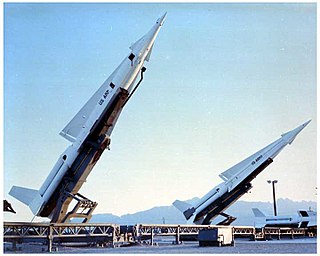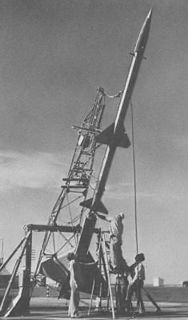Related Research Articles

The Boeing CIM-10 BOMARC was a supersonic ramjet powered long-range surface-to-air missile (SAM) used during the Cold War for the air defense of North America. In addition to being the first operational long-range SAM and the first operational pulse doppler aviation radar, it was the only SAM deployed by the United States Air Force.

In electronics and telecommunications, a radio transmitter or just transmitter is an electronic device which produces radio waves with an antenna. The transmitter itself generates a radio frequency alternating current, which is applied to the antenna. When excited by this alternating current, the antenna radiates radio waves.

The Nike Hercules, initially designated SAM-A-25 and later MIM-14, was a surface-to-air missile (SAM) used by U.S. and NATO armed forces for medium- and high-altitude long-range air defense. It was normally armed with the W31 nuclear warhead, but could also be fitted with a conventional warhead for export use. Its warhead also allowed it to be used in a secondary surface-to-surface role, and the system also demonstrated its ability to hit other short-range missiles in flight.
Semi-active radar homing (SARH) is a common type of missile guidance system, perhaps the most common type for longer-range air-to-air and surface-to-air missile systems. The name refers to the fact that the missile itself is only a passive detector of a radar signal—provided by an external ("offboard") source—as it reflects off the target. Semi-active missile systems use bistatic continuous-wave radar.

Rome Laboratory is the US "Air Force 'superlab' for command, control, and communications" research and development and is responsible for planning and executing the USAF science and technology program.
Mount Hebo Air Force Station is a closed United States Air Force General Surveillance Radar station. It is located 5.2 miles (8.4 km) east-southeast of Hebo, Oregon, located at the top of 3,154-foot (961 m) Mount Hebo. It was closed in 1980.
The Downrange Anti-missile Measurement Program or DAMP was an applied research project to obtain scientific data, just prior to and during re-entry, on intermediate- and intercontinental-range ballistic missiles as they returned to earth. The program was funded by the Advanced Research Projects Agency (ARPA) under the technical direction of the Army Ordnance Missile Command (AOMC) during the period 1 January 1959 through 30 September 1963.

The AN/FPS-16 is a highly accurate ground-based monopulse single object tracking radar (SOTR), used extensively by the NASA manned space program, the U.S. Air Force and the U.S. Army. The accuracy of Radar Set AN/FPS-16 is such that the position data obtained from point-source targets has azimuth and elevation angular errors of less than 0.1 milliradian and range errors of less than 5 yards (5 m) with a signal-to-noise ratio of 20 decibels or greater.

Radio is the technology of signaling and communicating using radio waves. Radio waves are electromagnetic waves of frequency between 30 hertz (Hz) and 300 gigahertz (GHz). They are generated by an electronic device called a transmitter connected to an antenna which radiates the waves, and received by another antenna connected to a radio receiver. Radio is very widely used in modern technology, in radio communication, radar, radio navigation, remote control, remote sensing, and other applications.

The 35th Bombardment Squadron is an inactive United States Air Force unit. It was activated in January 1940 as the United States built up its armed forces prior to World War II. In the fall of 1941, it deployed to the Caribbean and, following the attack on Pearl Harbor engaged in antisubmarine patrols. Following the transfer of the land based antisubmarine mission to the Navy, and with the lessening of threats to the Panama Canal, the squadron returned to the United States, where it was disbanded in June 1944.

The Unified S-band (USB) system is a tracking and communication system developed for the Apollo program by NASA and the Jet Propulsion Laboratory (JPL). It operated in the S band portion of the microwave spectrum, unifying voice communications, television, telemetry, command, tracking and ranging into a single system to save size and weight and simplify operations. The USB ground network was managed by the Goddard Space Flight Center (GSFC). Commercial contractors included Collins Radio, Blaw-Knox, Motorola and Energy Systems.
The SAGE radar stations of Air Defense Command were the military installations operated by USAF squadrons using the 1st automated air defense environment and networked by the SAGE System, a computer network. Most of the radar stations used the Burroughs AN/FST-2 Coordinate Data Transmitting Set (CDTS) to automate the operator environment and provide radar tracks to sector command posts at SAGE Direction Centers (DCs), e.g., the Malmstrom Z-124 radar station was co-located with DC-20. The sector/division radar stations were networked by DCs and Manual Control Centers to provide command, control, and coordination for ground-controlled interception of enemy aircraft by interceptors such as the F-106 developed to work with the SAGE System.

The 6th Air Defense Missile Squadron was an air defense unit of the United States Air Force. It was assigned to the New York Air Defense Sector of Aerospace Defense Command, at Suffolk County Air Force Base, New York, where it was inactivated on 15 December 1964. The squadron had its headquarters at Suffolk County Air Force Base, while the firing batteries of the squadron were at the nearby Suffolk County Air Force Base Missile Annex.

The Reeves AN/MSQ-77 Bomb Directing Central, Radar was a USAF automatic tracking radar/computer system for command guidance of military aircraft during Vietnam War bomb runs at nighttime and during bad weather. Developed from the Reeves AN/MSQ-35, the AN/MSQ-77 reversed the process of Radar Bomb Scoring by continually estimating the bomb impact point before bomb release with a vacuum tube ballistic computer. Unlike "Course Directing Centrals" which guided aircraft to a predetermined release point, the AN/MSQ-77 algorithm continuously predicted bomb impact points during the radar track while the AN/MSQ-77's control commands adjusted the aircraft course. A close air support regulation prohibited AN/MSQ-77 Combat Skyspot bombing within 1,000 yd (910 m) of friendly forces unless authorized by a Forward Air Controller, and "on several occasions" strikes were as close as 273 yd (250 m).

Boeing's Ground-to-Air Pilotless Aircraft (GAPA) was a short-range anti-aircraft missile (SAM) developed in the late 1940s by the US Army Air Force, and then the US Air Force after 1948. It was given the reference number SAM-A-1, the first Surface-to-Air Missile (SAM) in the 1947 tri-service designation system. By 1950 over 100 test rockets had been launched using a variety of configurations and power plants, with one launch in 1949 setting the altitude record for a ramjet powered vehicle at 59,000 ft (18,000 m).

BOMARC Site RW-01 is a 75-acre (30 ha) fenced-off site contaminated primarily with "weapons-grade plutonium (WGP), highly-enriched and depleted uranium." On 7 June 1960 an explosion in a CIM-10 Bomarc missile fuel tank caused the accident and subsequent contamination. The explosion occurred at Launcher Shelter 204, McGuire AFB, Ocean County, New Jersey, approximately 16.1 miles (25.9 km) south-southeast of Trenton, New Jersey. Launcher Shelter 204 was one of fifty-four located at McGuire AFB, operated by the 46th Air Defense Missile Squadron.
The Suffolk County Air Force Base Missile Annex is a Formerly Used Defense Site (NY29799F12240/C02NY0714) on Long Island that was a CIM-10 Bomarc missile complex during the Cold War, 2 mi (3.2 km) west of Suffolk County Air Force Base. Planned in 1955 for completion in February 1960 and activated as the 2nd operational BOMARC complex on 1 December 1959, the annex was part of the New York Air Defense Sector defenses. The annex included a Launch Area with 56 Mode II Launcher Shelters in 2 flights

The AN/FPQ-16 Perimeter Acquisition Radar Attack Characterization System is a powerful United States Space Force phased-array radar system located in North Dakota. It is the second most powerful phased array radar system in the US Space Force's fleet of missile warning and space surveillance systems.
The Venice missile launch complex was a Cold War Regulus missile firing installation "adjacent to the Venice Municipal Airport" on the Venice, Florida, beach. Beginning in 1959, KD2U-1 drone versions of the Regulus were JATO-launched from the strip of beach in front of the airport, flew across the Gulf of Mexico for simulating a penetrating enemy bomber for test interception, and then were "recovered on the runway at Eglin" AFB. The launch complex was one of several Eglin missile range facilities and conducted the "Regulus 2, KD2U intercept missile test [on] September 3, 1959" in which the "first launch of the Air Force's new Bomarc IM-99A missile [successfully intercepted] the Regulus 2 missile at 35,000 feet altitude and at supersonic speed"
During World War II, the German Army relied on an diverse array of communications to maintain contact with its mobile forces and in particular with its armoured forces. Most of this equipment received the generic prefix FuG for Funkgerät, meaning "radio device". Occasionally the shorted Fu designation were used and there were exceptions to both these systems. Number ranges were not unique across the services so sometimes different equipment used by different services had the same FuG prefix. This article is a list and a description of the radio equipment.
References
- ↑ Distances of each GAT Facility from the Launch Area were tbd (Patrick), tbd (Hurlburt)(http://www.radomes.org/museum/HurlburtFieldBOMARCFLGATSite.html/documents%5B%5D ) 1 mile (McGuire), 2⅓ mi (Suffolk), 2¼ mi (Otis), 4½ mi (Dow), 4½ mi (Langley), tbd (Sault Ste. Marie), tbd (Ottawa).
- ↑ IM-99 Weapon System: 26 October - 28 November 1958 (PDF) (Report). 17 December 1958. Archived from the original (PDF) on 18 February 2013. Retrieved 2013-08-04.
- IM-99A Bases Manual (Report). Seattle, Washington: Boeing: Pilotless Aircraft Division. December 3, 1959.
Differences in the Langley Base layout are due to planning for accommodation of the advanced missile system [IM-99B] ground equipment with [previous] equipment for the IM-99A system